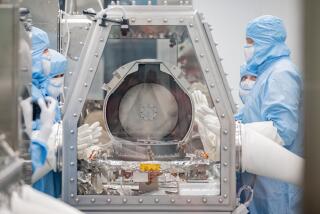Rescued Satellite’s Weathered Condition Delights Scientists
- Share via
KENNEDY SPACE CENTER — Scientists got their first look at a rescued science satellite Tuesday and said they were delighted with its condition despite some wear and tear from six years in space.
Wearing contamination-proof clothing and standing on an observation platform several feet away, scientists watched as the shuttle Columbia’s 60-foot-long cargo bay doors opened to reveal the Long Duration Exposure Facility.
The opening of the doors was the first step toward removing the 11-ton LDEF with a large crane, placing it in an airtight canister and moving it from the shuttle processing facility to a sterilized building several miles away for close examination. The work was expected to last much of the night.
Columbia’s astronauts retrieved the laboratory 200 miles out in space on Jan. 12, snaring it just weeks before it was to drop into the atmosphere and die a fiery death.
LDEF project chief William H. Kinard trained binoculars on the satellite and said it appeared to be a little more weathered than pictures taken in space indicated.
“There are lots of small micrometeoroid craters,” Kinard said. He said there was some discoloration, and foil covering some experiments had been torn.
“But that’s why we sent it up there, to find out what happens to materials after a long time in the space environment,” he said. “We’re delighted with the condition.”
There are 57 experiments attached to LDEF’s exterior, and scientists and engineers want to see how the various materials in them fared during their long exposure to radiation, micrometeoroids and other phenomena in space.
The experiments are expected to yield information that will be valuable in designing future long-duration spacecraft, including the manned space station that is scheduled to be assembled in orbit in the mid-1990s.
Four teams will study the recovered laboratory for about three weeks, photographing it and jotting down their observations. The teams are composed of specialists in space debris, materials, spacecraft systems and radiation.
Starting in mid-February, the experiments will be covered with protective aluminum and removed one by one from the satellite’s racks. They will be delivered to scientists throughout the nation and Western Europe for detailed study.
The satellite has 21 materials, coating and thermal systems experiments, five power and propulsion experiments, 17 science experiments and 14 optics and electronic experiments.
More to Read
Sign up for Essential California
The most important California stories and recommendations in your inbox every morning.
You may occasionally receive promotional content from the Los Angeles Times.












